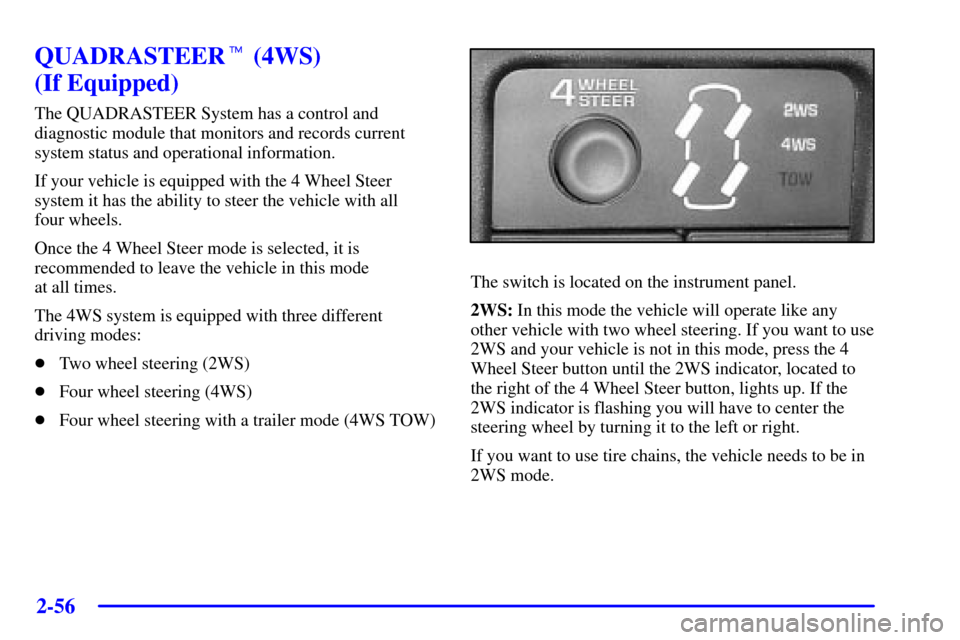Page 136 of 497

2-56
QUADRASTEER� (4WS)
(If Equipped)
The QUADRASTEER System has a control and
diagnostic module that monitors and records current
system status and operational information.
If your vehicle is equipped with the 4 Wheel Steer
system it has the ability to steer the vehicle with all
four wheels.
Once the 4 Wheel Steer mode is selected, it is
recommended to leave the vehicle in this mode
at all times.
The 4WS system is equipped with three different
driving modes:
�Two wheel steering (2WS)
�Four wheel steering (4WS)
�Four wheel steering with a trailer mode (4WS TOW)
The switch is located on the instrument panel.
2WS: In this mode the vehicle will operate like any
other vehicle with two wheel steering. If you want to use
2WS and your vehicle is not in this mode, press the 4
Wheel Steer button until the 2WS indicator, located to
the right of the 4 Wheel Steer button, lights up. If the
2WS indicator is flashing you will have to center the
steering wheel by turning it to the left or right.
If you want to use tire chains, the vehicle needs to be in
2WS mode.
Page 137 of 497

2-57
4WS: In this mode all four wheels will help steer the
vehicle. If you want to use 4WS, and your vehicle is not
in this mode, press the 4 Wheel Steer button, until the
4WS indicator, located to the right of the 4 Wheel Steer
button, lights up. If the 4WS indicator is flashing you
will have to center the steering wheel by turning it to the
left or right.
Slower Speed (below 40 m.p.h.)
At slower speeds the front and rear wheels will turn in
opposite directions. This helps the vehicle make tighter
turns, such as during parking, cornering and turning into
tight spaces.
Higher Speeds (40 m.p.h. and above)
At higher speeds the front and rear wheels will turn in
the same direction. This improves stability of the vehicle
during lane changes and sweeping turns.
4WS TOW: The 4WS TOW mode provides enhanced
stability allowing the trailer to follow the path of the tow
vehicle more closely, especially during lane changes.
In this mode the system operates much like the 4WS
mode, but is enhanced for trailer towing. It is
recommended for all types and weights of trailers.
To engage the 4WS TOW mode, press the 4 Wheel Steer
button until the 4WS and TOW indicators light up on
the instrument panel. If the TOW indicator is flashing
you will have to center the steering wheel by turning it
to the left or right. While in the 4WS TOW mode, it is
possible the steering wheel may be slightly off center.
Page 138 of 497
2-58
Car Washes for QUADRASTEER
Equipped Vehicles
NOTICE:
Because your vehicle has a wider rear track some
car washes may be too narrow for your vehicle.
Conveyor systems on some automatic car washes
may damage your vehicle. Only use conveyor
system car washes with 13
-inch (33 cm) wide
conveyor rails and/or stationary washes with at
least 82 inches (208 cm) between the rails. Before
using the car wash check with the manager.
Horn
To sound the horn, press the center pad on the
steering wheel.
Page 139 of 497
2-59
Tilt Wheel
A tilt wheel allows you to adjust the steering wheel
before you drive. You can raise it to the highest level
to give your legs more room when you exit and enter
your vehicle.
The tilt steering wheel lever
is located on the lower left
side of the column.
To tilt the wheel, hold the steering wheel and pull the
lever. Then move the steering wheel to a comfortable
position and release the lever to lock the wheel in place.
Turn Signal/Multifunction Lever
The lever on the left side of the steering column
includes the following:
�Turn and Lane Change Signals
�Headlamp High/Low Beam Changer
�Flash
-to-Pass Feature
�Windshield Wipers
�Windshield Washer
�Cruise Control (If Equipped)
For information on the exterior lamps, see ªExterior
Lampsº earlier in this section.
Page 171 of 497

2-91
Volume Control: You can control the volume of the
OnStar System using either the volume knob on the
radio or if equipped, the steering wheel volume controls.
Telltale Light: This light will indicate the status of
the system. A solid green light will come on when you
start the vehicle to let you know that the system is on
and is ready to make or receive calls.
If the light blinks green it means that an incoming or
outgoing call is in progress. Press the Communication
button if you notice the light blinking and you are not
on a call.
The light will be red in the event of an OnStar system
malfunction. If this occurs press the OnStar button to
attempt to contact an advisor. If the connection is made,
the advisor will assist you with steps to take to make
sure that the system is functioning properly. If you
cannot contact the advisor, take your vehicle to your
dealership as soon as possible for assistance.
Cellular Antenna: The cellular antenna on the outside
of your vehicle is critical to effective communications
using the OnStar system. Optimum cellular reception
can be obtained when the mast is straight up and down.
OnStar Services
The following services are available within OnStar
service plans. Your vehicle comes with a specific
one
-year service plan that allows use of some or all of
the following services.
�Automatic Notification of Air Bag
Deployment: If an air bag deploys, a priority
emergency signal is sent automatically to the center.
An advisor will locate your vehicle's position, try to
contact you and assist you in the situation. If the
center is unable to contact you, an emergency service
provider will be contacted.
�Stolen Vehicle Tracking: Call the center at
1
-888-4-ONSTAR (1-888-466-7827) to report
your vehicle stolen. The system can then attempt to
locate and track your vehicle and the advisor will
assist the proper authorities.
�Roadside Assistance with Location: For vehicle
breakdowns, press the OnStar Services button. An
advisor will contact the appropriate help.
�Remote Diagnostics: If an instrument panel
light comes on, press the OnStar Services button.
An advisor can perform a check of the engine
on
-board computer, and recommend what action
needs to be taken.
Page 229 of 497
4-
4-1
Section 4 Your Driving and the Road
Here you'll find information about driving on different kinds of roads and in varying weather conditions.
We've also included many other useful tips on driving.
4
-2 Defensive Driving
4
-3 Drunken Driving
4
-6 Control of a Vehicle
4
-6 Braking
4
-9 Traction Assist System (TAS) (Option)
4
-12 Steering
4
-14 Off-Road Recovery
4
-14 Passing
4
-16 Loss of Control
4
-17 Off-Road Driving with Your
Four
-Wheel-Drive Vehicle
4
-34 Driving at Night4
-35 Driving in Rain and on Wet Roads
4
-38 City Driving
4
-39 Freeway Driving
4
-40 Before Leaving on a Long Trip
4
-41 Highway Hypnosis
4
-42 Hill and Mountain Roads
4
-44 Winter Driving
4
-48 Recreational Vehicle Towing
4
-52 Loading Your Vehicle
4
-62 Camper Wiring Harness (If Equipped)
4
-62 Pickup Conversion to Chassis Cab
4
-63 Towing a Trailer
Page 234 of 497

4-6
Control of a Vehicle
You have three systems that make your vehicle go where
you want it to go. They are the brakes, the steering and
the accelerator. All three systems have to do their work
at the places where the tires meet the road.
Sometimes, as when you're driving on snow or ice, it's
easy to ask more of those control systems than the tires
and road can provide. That means you can lose control
of your vehicle.
Braking
Braking action involves perception time and
reaction time.
First, you have to decide to push on the brake pedal.
That's perception time. Then you have to bring up
your foot and do it. That's reaction time.
Average reaction time is about 3/4 of a second. But
that's only an average. It might be less with one driver
and as long as two or three seconds or more with
another. Age, physical condition, alertness, coordination
and eyesight all play a part. So do alcohol, drugs and
frustration. But even in 3/4 of a second, a vehicle
moving at 60 mph (100 km/h) travels 66 feet (20 m).
That could be a lot of distance in an emergency, so
keeping enough space between your vehicle and others
is important.
And, of course, actual stopping distances vary greatly
with the surface of the road (whether it's pavement or
gravel); the condition of the road (wet, dry, icy); tire
tread; the condition of your brakes; the weight of the
vehicle and the amount of brake force applied.
Page 237 of 497

4-9
Remember: Anti-lock doesn't change the time you need
to get your foot up to the brake pedal or always decrease
stopping distance. If you get too close to the vehicle in
front of you, you won't have time to apply your brakes
if that vehicle suddenly slows or stops. Always leave
enough room up ahead to stop, even though you have
anti
-lock brakes.
Using Anti
-Lock
Don't pump the brakes. Just hold the brake pedal down
firmly and let anti
-lock work for you. You may feel the
brakes vibrate, or you may notice some noise, but this
is normal.
Braking in Emergencies
With anti-lock, you can steer and brake at the same
time. In many emergencies, steering can help you more
than even the very best braking.
Traction Assist System (TAS) (Option)
Your vehicle may have a Traction Assist System (TAS)
that limits wheel spin. This is especially useful in
slippery road conditions. The system operates only if it
senses that one or both of the rear wheels are spinning or
beginning to lose traction. When this happens, the
system reduces engine power to limit wheel spin.
This light will come
on when the TAS is
limiting wheel spin.
See ªLow Traction Lightº
in the Index.
You may hear or feel the system working or notice a
lack of accelerator response, but this is normal.